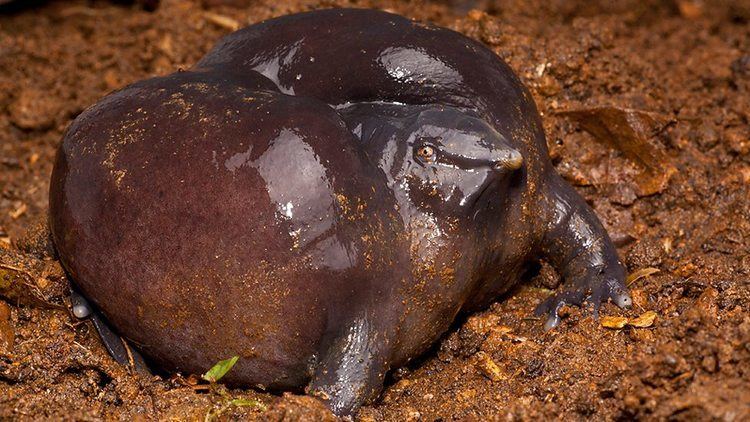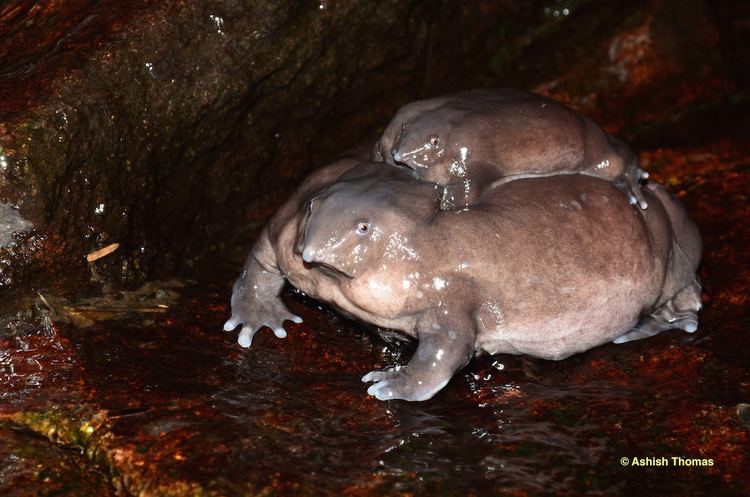Rank Species Phylum Chordata | Family Sooglossidae Higher classification Nasikabatrachus Order Frog | |
 | ||
Genus NasikabatrachusBiju & Bossuyt, 2003 Scientific name Nasikabatrachus sahyadrensis Similar Frog, Sooglossidae, Glass frog, Red‑lipped batfish, Umbonia spinosa | ||
Weird purple frog
Nasikabatrachus sahyadrensis is a frog species belonging to the family Sooglossidae. It can be found in the Western Ghats in India. Names in English that have been used for this species are purple frog, Indian purple frog, or pignose frog. Although the adult frog was formally described in October 2003, the taxon was recognized much earlier by its tadpole, which had been described in 1918. With its closest relatives in the Seychelles, Nasikabatrachus is thought to have evolved separately for millions of years. Its discovery also adds to the evidence that Madagascar and the Seychelles separated from the Indian landmass sometime well after the breakup of Gondwana had started.
Contents
- Weird purple frog
- Romance of the purple frog nasikabatrachus sahyadrensis
- History of the discovery
- Description
- Distribution
- Ecology
- References

Romance of the purple frog nasikabatrachus sahyadrensis
History of the discovery

The species was described from specimens collected in the Idukki district of Kerala by S.D. Biju from the Tropical Botanic Garden and Research Institute in Palode, India, and Franky Bossuyt from the Vrije Universiteit Brussel (Free University of Brussels), in 2003. However, it was already well known to the local people and several earlier documented specimens and publications had been ignored by the authors in the 2003 paper that describes the genus and species.
Description

The body of Nasikabatrachus sahyadrensis appears robust and bloated and is relatively rounded compared to other more dorsoventrally flattened frogs. Its arms and legs splay out in the standard anuran body form. Compared to other frogs, N. sahyadrensis has a small head and an unusual, pointed snout. Adults are typically dark purplish-grey in color. Males are about a third of the length of females. The specimen with which the species was originally described was 7.0 cm long from the tip of the snout to the vent. Tadpoles of the species had been described in 1917 by Nelson Annandale and C. R. Narayan Rao as having oral suckers that allowed them to live in torrential streams. Suckers are also present in rheophilic fishes of genera such as Glyptothorax, Travancoria, Homaloptera, and Bhavania, adaptations that are the result of convergent evolution. Some of these fishes co-occur with Nasikabatrachus tadpoles in the hill streams. Its vocalization is a drawn-out harsh call that sounds similar to a chicken clucking.
Distribution

Earlier thought to be restricted to the south of the Palghat Gap in the Western Ghats, additional records have extended its known range farther north of the gap. The species is now known to be quite widely distributed in the Western Ghats, ranging from the Camel's Hump Hill Range in the north, all the way to the northernmost portions of the Agasthyamalai Hill Range in the south.
Ecology
The frog spends most of its life underground and surfaces only during the monsoon, for mating. With few field scientists out in the field during the rainy season the species was discovered and studied only in recent times. Males emerge to call beside temporary rainwater streams. They mount females and grip them (amplexus) along the veterbral column. Around 3000 eggs are laid in a rock pool and the tadpoles metamorphose after around 100 days.

Unlike many other burrowing species of frogs that emerge and feed above the ground, this species has been found to forage underground, feeding mainly on termites using its tongue and a special buccal groove.
In 2015, tadpoles of the species were discovered to be traditionally consumed by local tribesmen.
